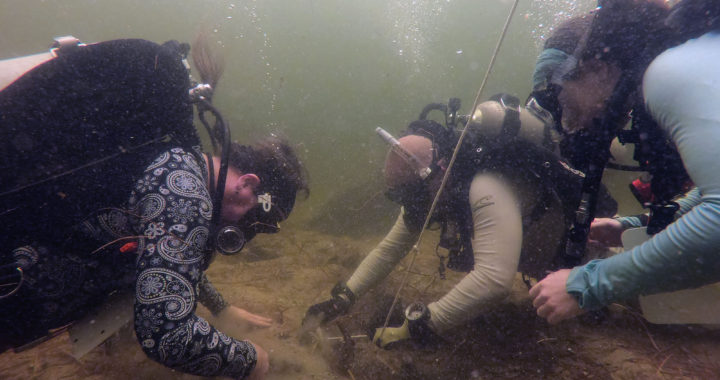I learned several lessons about fieldwork and research a long time ago. One, it never goes as planned; and two, as a result, you usually wind up with more questions than answers when you’re done. Finally, THREE, as a result of these first two variables, you’re usually never, truly done with research.
All three of these factors were very much in play when we went back to Apalachee Bay during the second week of August. We planned this round of assessment to delineate the full extents of the Econfina Channel site, which we’ve been working on since 2014. Funny thing about that site is that every time we go out to work on it, we find more of it. After two years out of the water due to COVID, we thought it was time to finally address that question. How big IS this thing, really?
For those of you who are wondering what an Econfina Channel site is and why you should even care: this is a large submerged site in about 10 feet of water (3 meters for those of you who prefer metric) that consists of a bunch of rocky outcrops where stone tools were made, a huge midden (trash dump, if we’re being honest) made of oyster shell, and a freshwater spring. It was submerged no later than 4,500 years ago, and it’s one of only a few such sites of this type documented in marine contexts.
So, it’s kind of cool, and it can potentially answer a number of important archaeological questions – not the least of which is, how well do these sites hold up during and after being drowned by sea level rise. And, what exactly were people DOING on that coastline before it went underwater?
The plan was to relocate the site, fix a buoy on it, then carry out visual survey to map in site components, once and for all. What could possibly be more straightforward than that? Turns out, quite a lot.
You see, the site was first identified in the late 1980s using LORAN-C, which is a system that relies on triangulation instead of a fixed GPS coordinate system. Translation from LORAN-C introduces the potential for error. Fortunately, the area is quite shallow (less than 15 feet deep), but visibility in the water isn’t great – usually no more than 20 feet, and usually less.
This means that we typically navigate to the coordinates, put a dive team over the side in snorkel gear, and have them look around to see if they recognize the locale. If not, we offset, usually using old coast guard navigation charts along with site maps from all previous surveys. Wash, rinse, and repeat. This, folks, is how we keep finding new site components.
And this process is what led to us finding an entirely new site.
We started our visual survey northwest of the coordinates using a different GPS unit than the ones we had used before (this detail will become important later, trust me). After visually identifying the paleochannel from the boat (water clarity was at least good enough to do that), we tossed some divers off the side, and they came up reporting the typical site components – shell deposits around rocky outcrops. This is exactly what the site looks like. We felt quite pleased with ourselves, stuck a buoy on it, continued feeling smug as we took a new set of GPS coordinates on the location (you can never have enough of these!), and went back to the dock.
Smug was replaced by Consternation when we put the new coordinates in the map database back at the field house, however. That’s when it became clear that we were about 2/3 of a mile away from the actual numbers we normally use. Best we can figure is that a distance conversion got mixed up somewhere along the way when translating our coordinates over to the unit we used to navigate to the site.
This completely upended the field plan. We had an entirely new site, and it appeared to be BIG. Just like the original one, located on the same submerged river channel, and composed of pretty similar stuff. We had to completely shift gears to evaluate this new locale, actually find the old site for real this time, and compare.
It didn’t go as planned, we now have more questions than before, and we are definitely, absolutely, not even close to done. To be honest, these are not bad problems to have, but our field schedule is definitely shifting accordingly!
Wander back over this way for Part III, wherein we spend some quality time with marine taxa, dead and alive, and start to fill in some details about what looks to be a pretty significant archaeological landscape offshore in the Gulf of Mexico!

